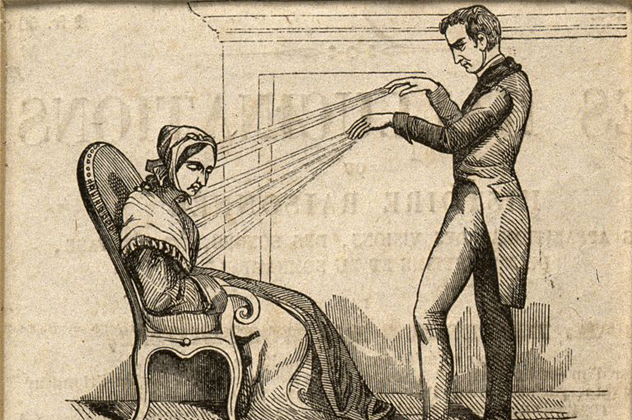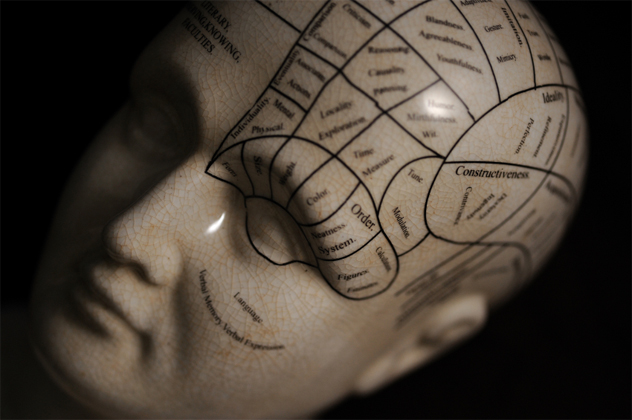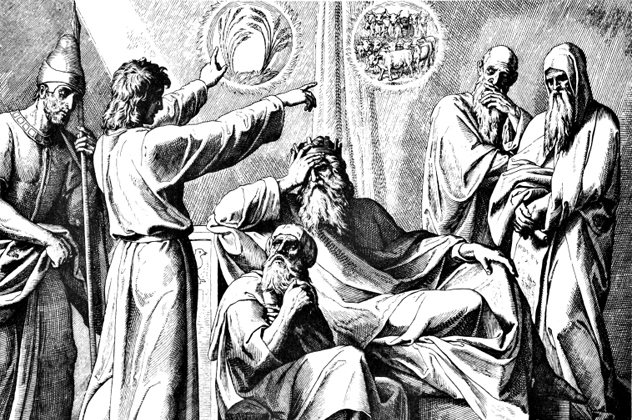 Our World
Our World  Our World
Our World  Weird Stuff
Weird Stuff 10 Fascinating Facts You Might Not Know About Snow
 Miscellaneous
Miscellaneous Top 10 Things Crypto Was Supposed to Change & What Actually Did
 History
History 10 Huge Historical Events That Happened on Christmas Eve
 Music
Music 10 Surprising Origin Stories of Your Favorite Holiday Songs
 History
History 10 Less Than Jolly Events That Occurred on December 25
 Weird Stuff
Weird Stuff 10 Funny Ways That Researchers Overthink Christmas
 Politics
Politics 10 Political Scandals That Sent Crowds Into the Streets
 Weird Stuff
Weird Stuff Ten Bizarre Facts About The Doge Meme
 Our World
Our World 10 Ways Your Christmas Tree Is More Lit Than You Think
 Our World
Our World 10 Archaeological Discoveries of 2025 That Refined History
 Weird Stuff
Weird Stuff 10 Fascinating Facts You Might Not Know About Snow
 Miscellaneous
Miscellaneous Top 10 Things Crypto Was Supposed to Change & What Actually Did
Who's Behind Listverse?

Jamie Frater
Head Editor
Jamie founded Listverse due to an insatiable desire to share fascinating, obscure, and bizarre facts. He has been a guest speaker on numerous national radio and television stations and is a five time published author.
More About Us History
History 10 Huge Historical Events That Happened on Christmas Eve
 Music
Music 10 Surprising Origin Stories of Your Favorite Holiday Songs
 History
History 10 Less Than Jolly Events That Occurred on December 25
 Weird Stuff
Weird Stuff 10 Funny Ways That Researchers Overthink Christmas
 Politics
Politics 10 Political Scandals That Sent Crowds Into the Streets
 Weird Stuff
Weird Stuff Ten Bizarre Facts About The Doge Meme
 Our World
Our World 10 Ways Your Christmas Tree Is More Lit Than You Think
Top 10 Bizarre Pre-Psychology Theories
Even in an era where we have stringent research standards, billion-dollar endowments at high-powered universities, and a scientist’s choice of brain scan equipment, we’re still constantly surprised by the human brain’s complexity and ability to adapt. So you can imagine how confusing human thought and behavior would have looked before the field of psychology even existed. One day, history will laugh at what we think we currently know about psychology; today, let’s laugh (or cry) at these 10 bizarre pre-psychological theories.
10Restrained Happiness

Muhammad ibn Zakariya al-Razi was a master physician around AD 1000 who also dipped his toes into philosophy and the study of happiness.
Al-Razi believed that the spirit was preoccupied with death, which naturally caused distress in the mind. To alleviate this distress, al-Razi believed that the individual must convince the spirit that good things happen at death, rather than bad. In order to do so, the individual must spend much of their time studying scripture instead of indulging in food or drink.
Current models of mindfulness, however, believe in living in the moment and not intentionally overindulging. Happiness exists within a variety of lifestyle choices. You can be equally joyous while studying the scriptures or while spending more nights than not at the bar. Additionally, having honest conversations about death with the dying is important, even if these conversations are not always rosy.
9Hysteria

Going all the way to ancient Greece, this is one of the oldest pre-psychological traditions. Hysteria was a medical condition that served as a catch-all for disruptive behavior in European civilizations and didn’t really disappear from the discourse until the past 100 years or so. Of course, it affected men and women differently. The male version described symptoms similar to today’s post-traumatic stress disorder and was diagnosed much less frequently.
The female variants of hysteria were faintness, irritability, loss of appetite, nervousness, sexual desire, and “a tendency to cause trouble.” The Greeks believed this unfortunate mental state was caused by a physical ailment known as “wandering womb,” which is as ridiculous and unscientific as it sounds.
According to Hippocrates, the womb was drawn to pleasant scents and disgusted by foul ones. When the womb found its regular location’s smell to be distasteful, it would wander to other places in the body. When this unusual myth was dispelled, sexual frustration became a clear underlying source, and skilled physicians began offering private masturbation sessions for women in Europe—many of whom knew nothing about their own genitals. Eventually, the awkwardness of this practice caught up with the physicians and led to the 18th-century invention of sex toys.
8Mesmerism

The word “mesmerism” comes from Austrian physician Franz Mesmer, who believed in an invisible magnetic fluid in humans and animals. When the magnetic field reached an imbalance, Mesmer believed, it caused hysteria. To treat the hysteria, Mesmer used a technique (creatively titled mesmerism) which involved putting magnets up to his patients’ bodies. His technique caused them to fall into a trance-like stupor that apparently healed them upon awakening. The practice garnered a bit of a following in Europe and the United States, including famous names like Wolfgang Amadeus Mozart and French queen Marie Antoinette.
Unfortunately for Mesmer, when the French government’s experts (one being Benjamin Franklin, a resident of Paris at the time) assessed his method, it concluded that the words Mesmer had used during his magnetic treatment were playing on the patients’ suggestibility and causing the stupor. The magnets were thrown out, but the intriguing debate between suggestibility and psychical powers was born, leading to the creation of hypnosis and its cousin, stage hypnosis.
7Demonic Possession

Another phenomenon that still appears in the minds of some today, demonic possession explained many modern mental disorders to our ancestors. With no real comprehension of neurology or abnormal psychology, outside forces causing unexplained behavior probably seemed to be the most obvious answer.
Bipolar disorder can cause alternating periods of depression and mania, day-long bursts of energy with little to no sleeping, spontaneous decision making, and an interruption of routine. A manic episode like this would have certainly mystified our ancestors and caused a ritualistic “casting out” of a demon. Schizophrenia could also be attributed to demonic possession. The presence of voices in one’s head could easily be attributed to other beings inside the mind. Many more psychological disorders could fall into this category, like psychosis and dissociative identity disorder.
In the mainstream lexicon, demons haunt or plague us figuratively, not literally. In this way, their general perception hasn’t changed much. Our demons are still difficulties that take time and energy to deal with, but now we cast them out through medicine and therapy, not Holy Water or isolation.
6Phrenology

Phrenology was developed around 1800 by Franz Gall, who had a novel idea: What if your brain was the source of your intelligence and your personality? And what if you could tell someone’s intelligence and behavioral pattern by measuring the shape of their head and studying the bumps and fissures on it? Phrenology contributions can be separated into three distinct categories—the true, the false, and the other.
True: Gall theorized that the brain was the organ of the mind. He was right about this and paved the way for neuroscience today. Gall pontificated about different regions of the brain being responsible for different personality traits, just another key facet of neuroscience.
False: You can actually determine someone’s intelligence or personality from looking at their head or measuring it. Some phrenologists used phrenology to “prove” the superiority of white, European males over others, and some still use this argument today. Essentially, Gall had the right theory and the wrong execution, and he picked up some of the wrong followers (like Nazis) along the way.
Other: Giving phrenology as a personal service is a taxable source of income in Michigan. Does Michigan know its racial demographic, and how many of their residents would have been hurt by this in a past life? Actually, if you’re in the para-psychological crew, you probably believe they really were hurt by it, because they had a past life.
5Lie Detection

A search engine query for “how to tell when someone is lying” brings up millions of results. Many of them offer basic analysis on noticing the obvious psychological signs of lying. Before the Internet, humans had to find ways to weed out the liars from the truth-tellers using their own style.
In ancient times, cultures around the world used ordeals to determine the veracity of accused liars. In India, an accused liar would be subject to the weight ordeal. In this trial, they were weighed, a judge would deliver an exhortation to the counterweight, and the liar was then weighed again. If the accused was lighter than before, they were honest. If not, they were dishonest. Most other ordeals were more gruesome. In Europe, an accused liar was resigned to the hot iron ordeal, where the potential falsifier stuck their tongue on a hot iron nine times. If they weren’t burned then they had told the truth. If their tongue did burn, they would be executed. When ordeals proved ineffective around the 17th century, societies moved to a more humane technique . . . torture.
Torture ranged from gory contraptions used in Medieval times to the enhanced interrogation employed as recently as the mid-2000s by the CIA. Fortunately for human rights, torture is ineffective for detecting lies, with a high number of false positives and unreliable information in general.
The 20th century brought along truth serums and the polygraph test. Truth serum (a drug administered to a subject with the intention of causing them to provide information they would not otherwise offer) certainly loosens the tongue, much like alcohol, but is still considered unreliable. The polygraph, on the other hand, measures one’s blood pressure, pulse, respiration, and other physiological measures to determine whether someone is lying. Sadly, it also is not too reliable as some people, like sociopaths, may not show any physiological change regardless of what they are saying. Others take countermeasures, like pricking themselves with a needle at random points during the test to skew the data.
Finally, the scientific community realized that greater understanding of the neurological processes behind lying must exist before lie detection can be an objective process. Essentially, until voice stress analysis research is finalized, you’re best off just trying to determine if the story you’re being told makes sense or not.
4Graphology

Graphologists study quirks and styles in handwriting to determine the writer’s psychological profile, personality traits, and mood at the time. Graphologists advertise their work as the ideal way to recruit candidates to jobs, tell personality compatibility, or even decide if you’re working in the right career. It’s all the rage in Europe at the moment, and it’s just about to turn the corner in the United States. If this all sounds too good to be true, well, it is.
Dazzi and Pendrabissi performed a study in which 101 college students provided an autobiographical writing sample to two graphologists. The students also provided personality information using the most common measure in psychology, the Big 5 Personality Traits. Using their written text, the graphologists created personality profiles for the students. Not only did they not match the Big 5 test results, but they didn’t even match each other. This type of study has been repeated over and over, and consistently produces no correlation between handwriting and personality.
3Dream Interpretation

This pre-psychological theory remains popular today in lieu of a universally accepted theory as to the real meaning of dreams. Beginning with metaphorical interpretation of symbols, it occurs often in the Bible. An early documented example was from the kingdom of Babylon, whose peaceful regime foreshadowed the tranquil nature of its modern location (the border between Iraq and Syria).
The Bible’s book of Daniel provides excellent anecdotes about Babylonian dream culture. It mentions that wizards, magicians, and astrologers could be hired for dream interpretation. Daniel, however, won the favor of the king after he deciphered that the freakish creature made of gold, silver, bronze, iron, clay, and mud in his dream had actually symbolized Babylon and several other future kingdoms.
In ancient China, dreams were considered an evaluation of reality and identity. One famous story is of Chuang Chou, who dreamed of flying around as a butterfly but found himself to be human when he awoke. Did Chuang dream of being a butterfly or did a butterfly dream of being Chuang? The Chinese thought of dreams less as an identification of symbolism and more as a philosophical exploration.
Later, Freud came into the discourse and followed the theme of symbolism. In his book The Interpretation of Dreams, Freud outlined the many ways dreams served as wish-fulfillment fantasies distorted through mental operations irrelevant to modern dream analysis. Essentially, we dream of what we want, and we have nightmares about our failures to receive our wishes.
Today, scientists believe in several theories for dreaming, including memory consolidation, problem solving, and random brain activity. However, most people still subscribe to the Freudian theory. Studies have shown that Americans are just as likely to skip a flight if they dream of a plane crash the night before as they are if a plane has recently crashed on their specific route.
2Racist Eugenics

The concept of eugenics was first recorded by Plato in The Republic with the idea of selectively breeding a “guardian” or elite class in Greece. Greece was homogeneous at the time and had little to do with race, and everything to do with moral character and intelligence. The term eugenics was coined by Francis Galton, who wrote the book Hereditary Genius. Galton postulated that talent is hereditary, and societies should stop wasting time protecting the untalented (the poor) and instead focus on facilitating a greater “race” of people. Speaking of race, his introduction to his amended edition of Genius notes that, ideally, society would be best served if a new race had sprung up that was superior over “the modern European,” the way “the modern European” was to the “negro.”
Soon after, the United States became interested in eugenics, leading to over 64,000 forced sterilizations of the poor, disabled, and “feeble-minded” in the early 1900s, especially in California. This horror show even helped inspire Adolf Hitler in his mass genocide of non-Aryans. Even after the Holocaust, forced sterilization continued to exist within the legal bounds of some American states, and it’s beginning to make a comeback. As artificial insemination and surrogate mothers renew the cycle of trait selection, some worry about how it could create a gap between the rich and poor.
1Parapsychology

One of the most prominent modern parapsychology labs, the Rhine Research Center, attempts to explain everything science cannot. This sounds interesting and potentially insightful until you remember that, long ago, psychology decided to study concepts that exist, not ones that consistently fail validity and reliability testing. Parapsychology covers a litany of paranormal phenomena, but focuses mostly on telepathy, clairvoyance, precognition, and psychokinesis.
Parapsychology peaked in popularity in the late 1800s, when many prominent educators and intellectuals joined the Society for Psychical Research in London. The field quickly lost its popularity when a torrent of the Society’s claims didn’t hold up to rigorous scientific examination. In 1884, Charles Richet performed a clairvoyance experiment in which he sealed playing cards in envelopes and had the subject guess their identity. The subject was highly successful, but when asked to replicate the feat in front of a group of scientists, his score fell to a chance-level equivalent.
+Conversion Therapy

A current pseudo-psychological theory is Conversion Therapy—the treatment of gay, lesbian, or otherwise not straight people. It is illegal in California but still practiced widely across the United States (mostly by family therapists who belong to The American Association of Marriage and Family Therapy).
The therapy presupposes that homosexuality is a mental disorder that causes a lack of character or morality, a stance not supported by the DSM-5, the APA, or any other health organization. The preferred outcome of the therapy is for the patient to “come out” as heterosexual. The efforts to convert the patient are done either via therapies or by ministries, and the views opposing homosexuality are generally either cultural or religious in nature.
Conversion therapy is opposed by all major medical organizations. It is considered harmful to the individual and to society. It tells the confused client that their beliefs are a mental disorder, or against a higher cultural or religious power. The APA shows anecdotal evidence of growing self-hatred through these camps, as well as a lower threshold for noticing surrounding prejudice. While the idea of moral fortitude (or lack thereof) causing a “disease” like homosexuality is surely pre-psychological, the misguided therapy itself uses some tenants of modern psychological treatment.
Connor is an incoming graduate student in sports psychology and mental health counseling at Boston University. He is also a long-suffering fan of the Seattle Supersonics. Follow his page on research-based life tips on Twitter or on Facebook.








